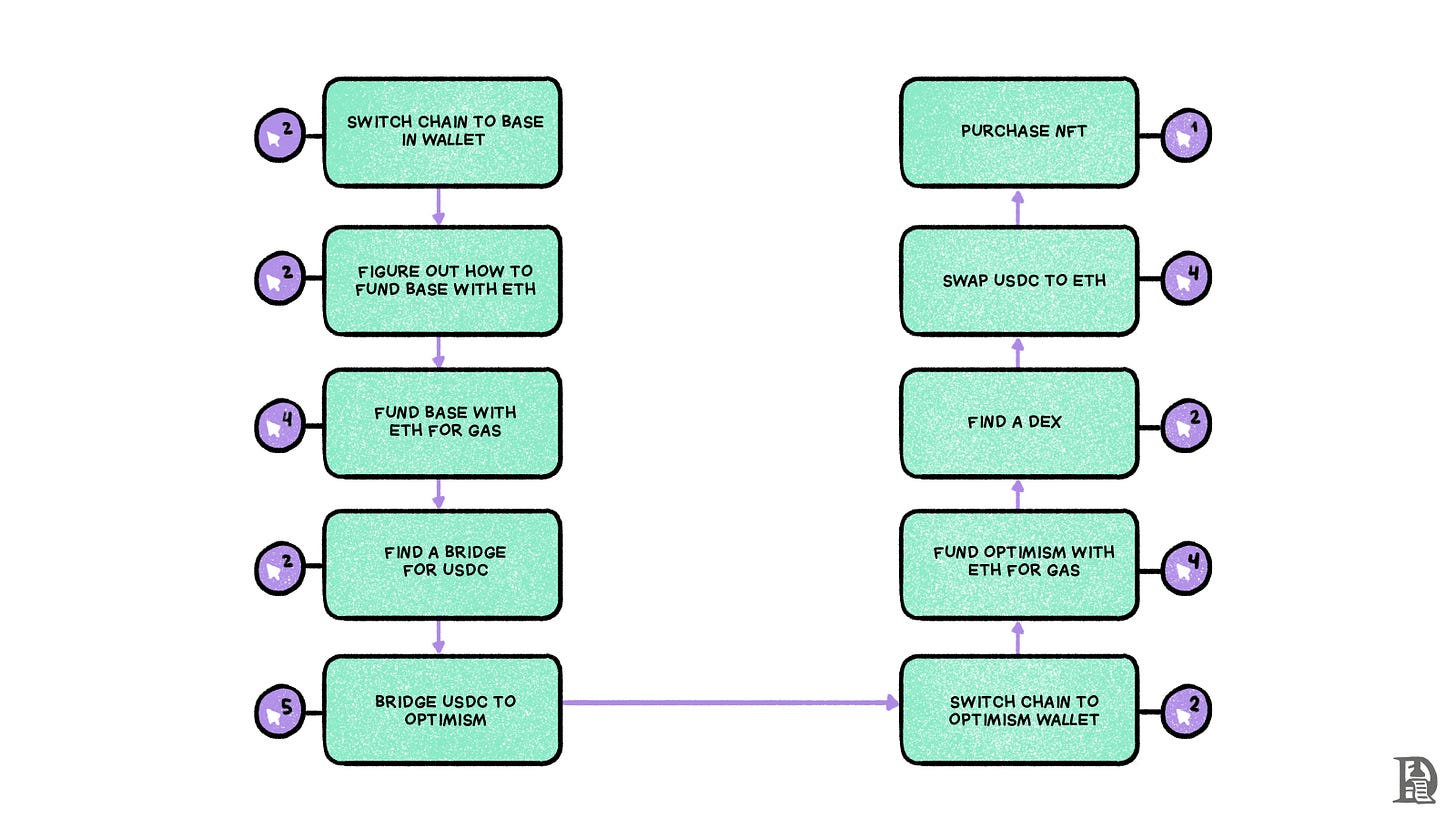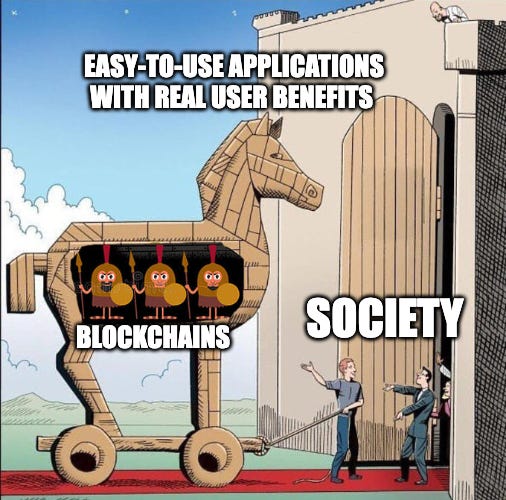Abstraction Is The Only Way Forward
How blockchains are already being leveraged without users knowing
After 15 years of building and iterating on the technical side, we are finally seeing blockchain-powered applications emerge from the small bubble of crypto Twitter into more mainstream usage.
A common thread among these applications is that the blockchain component is becoming increasingly abstracted away, making them great products rather than great blockchain products.
The level of abstraction differs depending on the use case, but the practical implication is that it’s easier for new users to onboard, use, and experience the value-add of the product.
Let’s look at a few examples:
Applications Abstracting Away The Blockchain
Helium Mobile offers phone plans with nationwide (US) coverage for $20. They’ve bootstrapped the 5G network using crypto-economic incentives - relying on operators who buy and maintain hotspots in exchange for rewards in the native token, rather than raising large amounts of capital upfront. While the operators need to be somewhat crypto-native, users of the phone plan don’t have to worry about any of that - they just benefit from the cheap phone plan. Helium Mobile already has close to 120k users and is now starting to let other carriers offload to the Helium Network.
Polymarket is a prediction market that runs on Polygon. It’s gotten more attention ahead of the upcoming US elections and is now regularly cited by mainstream media outlets. While the backend runs on the blockchain and bets are placed with the USDC stablecoin, the UX and onboarding process is very “web2-like”. Polymarket doesn’t require users to have a pre-existing wallet or stablecoins. Instead, new users sign up using familiar web2 logins (such as Google) and can choose between different onramps to convert USD or other currencies into stablecoins.
Identity solutions—The City of Buenos Aires recently announced an on-chain identity solution for 3.6 million eligible citizens, implemented on zkSync Era. A few weeks earlier, the Georgian opposition party announced its solution built on top of Rarimo. Both leverage zero-knowledge proofs (ZKPs) to increase data privacy and citizen empowerment while the UX remains as simple as any other mobile application. While these are only two examples, I expect more adoption in the digital identity space.
Two other noteworthy categories include stablecoin payments and gaming:
Stablecoins already settle trillions of dollars annually and have become a top 20 holder of US treasuries globally. While applications like Payy and Sling enable easy onboarding, transfers, and cross-border payments, the use of stablecoins in commerce is still limited (paying for things in the real world). However, this might change soon as Stripe's recent acquisition of stablecoin platform Bridge for $1.1bn indicates an increasing appetite from web2 companies. How would consumers and merchants benefit? Primarily cheaper fees and faster settlement. It’s also feasible that stablecoins remain mainly B2B and C2C, with the B2C angle taking longer to break through.

Stablecoins are already settling more value than Visa (source) Gaming is a category that many are excited about, but we’ve yet to see a breakthrough game with some blockchain component that’s also fun to play. One recent contender is the battle royale game Off The Grid, which quickly topped the list of free games on the Epic Games Store as it went live with early access. The in-game assets are issued as NFTs on the Avalanche blockchain, which aims to enable easier trading with cheaper fees and stronger guarantees around the assets owned. Fully on-chain games face a steeper uphill battle due to a lack of tooling and performance/scaling challenges.
Why Now?
The short answer is that many different pieces of the blockchain infrastructure stack are starting to mature.
Besides scaling and increasing throughput, investments over recent years have focused on components that improve the user experience. This has enabled developers to focus more on users and building competitive applications.
While none of these components sound particularly significant on their own, they add up. Some examples include:
Easier onboarding by leveraging familiar web2 authorization such as “sign in with Google/Apple”.
Biometric authentication for logging in and signing transactions.
Transaction fee sponsoring so users don’t need to pay for using the blockchain in a specific gas token (e.g. ETH or SOL). Instead, the application or a third party pays the gas fees.
Session keys enable making multiple transactions without signing every time, which is most relevant for use cases that require frequent signatures (e.g. games that run entirely on the blockchain).
Account recovery options in case you forget your login details. Instead of the usual 12/24 word seed phrase, we can now rely on social recovery, email, or a combination of methods (e.g. 2 out of 3).
Which Areas Still Need Working On?
Besides further scaling (both horizontally and vertically) to increase throughput and reduce latency, two significant frictions are still outstanding:
Chain abstraction - As the number of chains keeps growing, the experience of navigating these different chains remains clunky and painful for both users and developers. Chain abstraction is an umbrella term for anything that simplifies and streamlines this experience - reducing the required steps. One of the many recent examples is the Uniswap and Across partnership that enables in-app bridging across nine networks directly from the Uniswap Wallet and interface. This is one step closer to the experience of using one unified application rather than one application across nine different chains.

Privacy - Most blockchain interactions are fully public today, along with the complete transaction history. While non-intermediated privacy, i.e. privacy from all parties (governments, regulators, etc), might be too ambitious in the medium term, we should at least aspire to web2-level privacy guarantees where your data and transactions are private from other users and external observers. Even though there are encouraging signs of progress on this front, the lack of privacy remains a significant challenge for permissionless blockchains.

Different levels of privacy guarantees. Most blockchains today achieve none of these (source)
What Are The Downsides Of Abstraction?
Blockchains differ in their security properties and assumptions. A common criticism of abstraction is that it obfuscates this and adds reliance on third parties.
While it should be up to the user to decide which one they trust to keep their data and assets on, the counterargument is that most users aren’t well placed (or even interested) in determining those security tradeoffs.
Overall, abstraction seems to be the most reasonable path forward to increase blockchain adoption. While the vast majority will likely offload that responsibility to third parties (such as solver networks, wallets, or even “web3 rating agencies”), early adopters and “prosumers” still have the option of choosing which chain to keep their assets on.
This is similar to individual users having the option to send transactions directly over the SWIFT network if their bank is down or not functioning correctly. Most wouldn’t take that option due to the extra friction, but the option of doing that is a net improvement in cases where a third-party service can’t be relied upon.
Summary
There are many parallels between the early Internet and blockchains today. It’s still relatively new, clunky, and hard to understand unless you’re one of the early adopters.
However, we are making progress, and the underlying infrastructure has evolved significantly over the past few years. As the complexity is abstracted away from end-users, more good products that leverage blockchains are starting to emerge.
Even though we’ve done a decent job of abstracting away the blockchain when using a single blockchain, the larger vision is to enable applications and assets on different blockchains to talk to each other seamlessly—all without the user needing to know what’s happening on the backend.
Abstraction is the only way forward.





